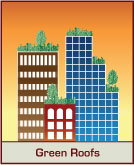 General Information
General InformationGreen Roofs
Systems
Drain Boxes
Drainage Channels
Aluminum Edge
Slope Stabilization
Components
Projects
Documents
Rainwater Harvesting
Ponds and Wetlands
Energy-Efficient Building
Waterproofing

GREEN ROOFS
Green roofs are roofs that are substantially covered with living plants. Although historical and archaeological evidence suggests that green roofs have been built for more than three thousand years, widespread acceptance has always been limited by the structural cost of supporting heavy soils and by the technical challenges of low-slope waterproofing. Recent advances in membrane waterproofing technology combined with the development of lightweight thin-profile green roofs have finally made green roofs practical for most new construction: there are now more than one billion square feet of lightweight green roofs!
WHY BUILD GREEN ROOFS? Although the structural, waterproofing, and drainage requirements of green roofs will always make them more expensive than bare roofs, green roofs offer significant long-term economical and environmental advantages that more than justify the higher initial cost:
• Green roofs are visually attractive. The variegated coloring of flowers, grasses, and wild herbs is more appealing than stark black or white monolithic surfaces. Green roofs can transform urban wastelands into urban gardens.
• Green roofs are energy-efficient. They are cool in the summer and can be as effective as white roofs in reducing the urban heat island effect. The thermal mass of the soil reduces heat gain and loss by isolating the building from temperature extremes.
• Green roofs significantly reduce stormwater runoff, typically retaining half to three-quarters of the annual rainfall and retarding the runoff of most of the remainder.
• Green roofs are permanent. By shielding the waterproofing from the sun and reducing temperature swings, synthetic membranes can last fifty years and more.
ANATOMY OF A GREEN ROOF: A modern green roof requires eight functional layers:
sturdy roof structure: Green roofs must typically support 25 to 100 pounds more load per square foot than conventional flat roofs. New roofs, whether made of wood, steel, or concrete, can be designed to support green roofs at minimal additional expense. Existing roofs almost always require costly structural reinforcing.
reliable waterproofing membrane: Leaks in green roofs can be very difficult to identify, and repairs or replacement can be expensive. For a long, maintenance-free life, green roof waterproofing must be sufficiently elastic to withstand building movement, must withstand ponded water, must be non-biodegradable, and must be resistant to root penetration. Some rubber and plastic sheet-applied and liquid-applied membranes meet these criteria but most asphalt products do not.
root-barrier/ponding membrane: If the primary waterproofing system is not resistant to root penetration, it can be covered with a secondary root-barrier membrane. Secondary membranes are also used with some green roof systems where water is intentionally ponded so that the primary waterproofing membrane still drains.
tough protection fabric: A synthetic fabric protects the waterproofing or root barrier/ponding membrane from mechanical damage during construction and roof maintenance. Protection fabrics typically weigh 500 to 900 grams per square meter (15 -27 ounces per square yard). Fabrics with enhanced water storage and capillarity are preferred for some green roof systems.
water-storing drainage layer: It is desirable to store water in green roofs to help plants survive through periods of dry weather. However, the dry-climate plants that thrive on green roofs will not survive unless excess water is rapidly drained from the plant root zone. The optimal combination of water storage and rapid drainage can be provided by several water-storing drainage products including well-graded granular inorganic media, dimpled plastic sheets, and ribbed fabric laminates.
non-clogging separation fabric: For the water storage and drainage layer to function properly, it must be kept free of soil. A synthetic soil separation fabric serves this function, but the fabric must have a structure that resists clogging from fine soil particles such as silts and clays.
engineered soil: Green roof soil is not ordinary soil. It must be lightweight, have good water storage characteristics, have a low organic content, have suitable chemical parameters, and have a good distribution of particle sizes.
appropriate plants: Green roof plants must survive in the green roof environment which if often hot and dry. Thin green roofs usually require sedums and herbs, whereas thicker green roofs can often accommodate a wide range of native plants.